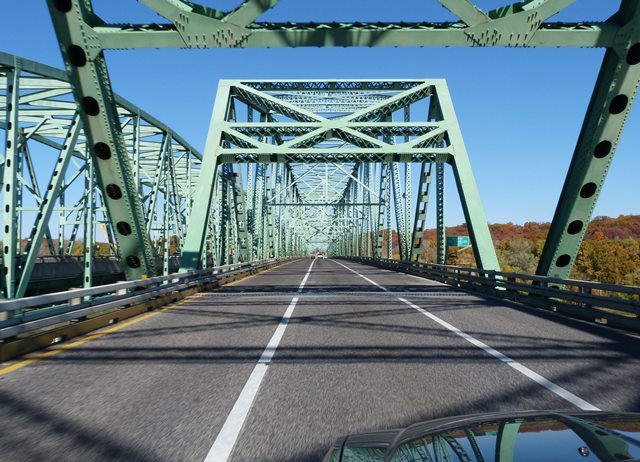We Recommend:
Bach Steel - Experts at historic truss bridge restoration.
BridgeHunter.com Phase 1 is released to the public! - Visit Now
Daniel Boone Bridge

Primary Photographer(s): Nathan Holth
Bridge Documented: November 2, 2013
I-64, US-40, and US-61 (Northbound and Westbound) Over Missouri River
Chesterfield: St. Louis County, Missouri and St. Charles County, Missouri: United States
Metal Continuous 16 Panel Rivet-Connected Warren Through Truss, Fixed and Approach Spans: Metal 6 Panel Rivet-Connected Warren Deck Truss, Fixed
1935 By Builder/Contractor: Kansas City Bridge Company of Kansas City, Missouri and Engineer/Design: Missouri State Highway Commission
1992
513.5 Feet (156.5 Meters)
2,614.0 Feet (796.7 Meters)
32.2 Feet (9.81 Meters)
4 Main Span(s) and 4 Approach Span(s)
5624

View Information About HSR Ratings
Bridge Documentation
This bridge no longer exists!
Bridge Status: This bridge was demolished in 2016 after it was replaced!View Archived National Bridge Inventory Report - Has Additional Details and Evaluation
View Original Plans For This Bridge
View MoDOT Historical Documentation For This Bridge
This bridge was a rare example of a riveted continuous through truss. It was particularly uncommon because it had four main spans, but they were configured as two two-span continuous truss bridge components. As a result, if the placement of piers is ignored, the bridge looks like it has two spans, instead of four. In 1991, the bridge was turned into a one-way couplet with the construction of a modern truss bridge next to it. The two bridges made a good comparison since the modern bridge lacks the beauty of the historic bridge with its simple beams that lack riveted elements like v-lacing and lattice.
Missouri once had one of the largest collection of large-span riveted continuous and cantilever truss bridges in the country, not surprising given the Missouri River runs right through the state, and one side of the state is bordered by the Mississippi. Nationwide large historic truss bridges of these types are not common yet are facing a staggering rate of demolition alongside an equally staggering lack of preservation. This is particularly true in Missouri, where preservation of bridges of this size is essentially non-existent with a couple exceptions in the City of St. Louis. The Missouri River has in particular been decimated, and the Daniel Boone Bridge will be one of the last remaining bridges of its kind on the Missouri River when it is demolished.
An excellent opportunity to preserve the Daniel Boone Bridge was dismissed. The Daniel Boone Bridge, which up until demolition serves full Interstate Highway traffic, could certainly have been left standing next to its replacement and been used for non-motorized traffic which cannot use the Interstate Highway itself. Even without rehabilitation, a bridge capable of carrying Interstate traffic could likely carry pedestrians for decades.
Be sure to view the historical documentation linked to at the top of this narrative to see a detailed history of this bridge, as well as original plan sheets for the bridge.
![]()
Photo Galleries and Videos: Daniel Boone Bridge
Bridge Photo-Documentation
Original / Full Size PhotosA collection of overview and detail photos. This gallery offers photos in the highest available resolution and file size in a touch-friendly popup viewer.
Alternatively, Browse Without Using Viewer
![]()
Bridge Photo-Documentation
Mobile Optimized PhotosA collection of overview and detail photos. This gallery features data-friendly, fast-loading photos in a touch-friendly popup viewer.
Alternatively, Browse Without Using Viewer
![]()
Maps and Links: Daniel Boone Bridge
This historic bridge has been demolished. This map is shown for reference purposes only.
Coordinates (Latitude, Longitude):
Search For Additional Bridge Listings:
Bridgehunter.com: View listed bridges within 0.5 miles (0.8 kilometers) of this bridge.
Bridgehunter.com: View listed bridges within 10 miles (16 kilometers) of this bridge.
Additional Maps:
Google Streetview (If Available)
GeoHack (Additional Links and Coordinates)
Apple Maps (Via DuckDuckGo Search)
Apple Maps (Apple devices only)
Android: Open Location In Your Map or GPS App
Flickr Gallery (Find Nearby Photos)
Wikimedia Commons (Find Nearby Photos)
Directions Via Sygic For Android
Directions Via Sygic For iOS and Android Dolphin Browser
USGS National Map (United States Only)
Historical USGS Topo Maps (United States Only)
Historic Aerials (United States Only)
CalTopo Maps (United States Only)

